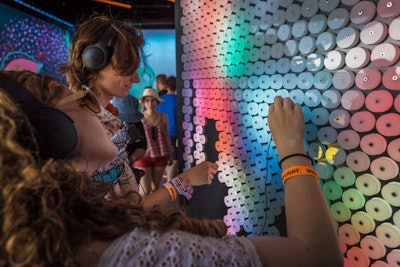
The Google Play Music Block at Panorama included a headphone jack wall where attendees could listen to curated playlists.
Photo: Courtesy of Panorama Music Festival
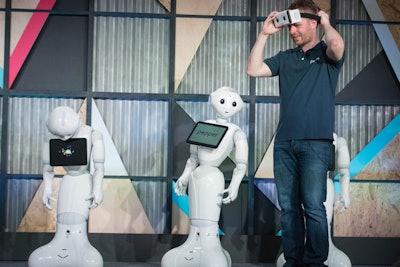
Google I/O in 2016 featured a presentation by SoftBank Robotics America that showed off Pepper, the humanoid robot.
Photo: Courtesy of Google
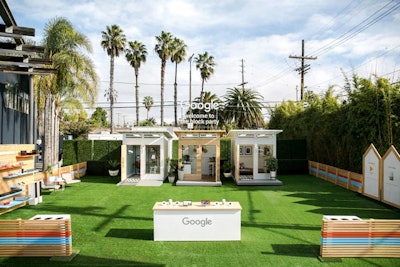
The Google Block Party activation in Los Angeles featured tiny homes inspired by three YouTube personalities.
Photo: Courtesy of Google
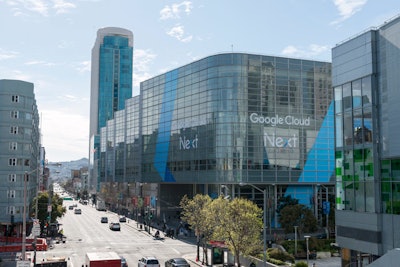
Google Cloud Next, a new event, took place at Moscone West and other nearby venues.
Photo: David J Crewe
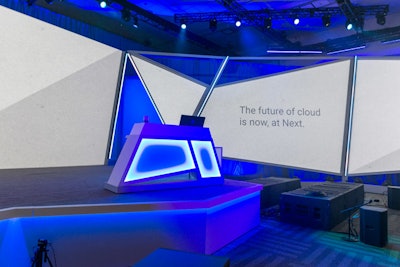
The keynote stage featured an angular podium.
Photo: David J Crewe
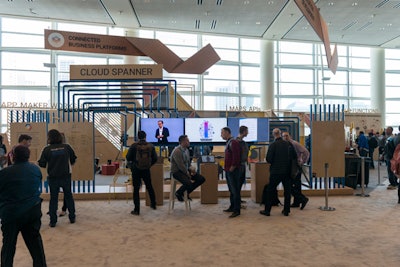
Pegboard-style signage added an element of whimsy.
Photo: David J Crewe
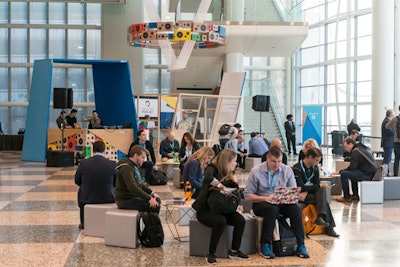
A fabricated DJ booth included images of colorful speakers, and the motif continued with a circular installation hanging above the space. Furniture rentals had an angular look in keeping with the style of the event's branding.
Photo: David J Crewe
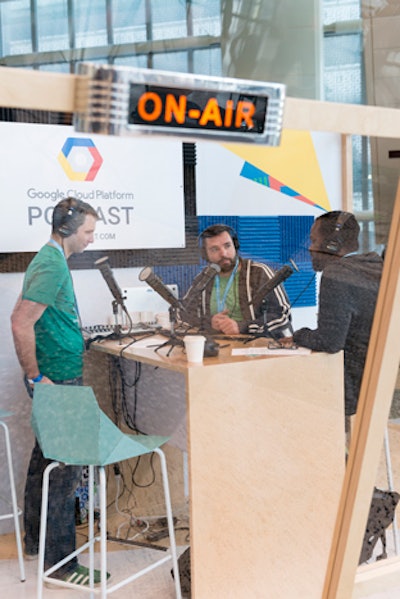
The build-out included a podcast recording booth with a retro-looking "On-Air" sign.
Photo: David J Crewe
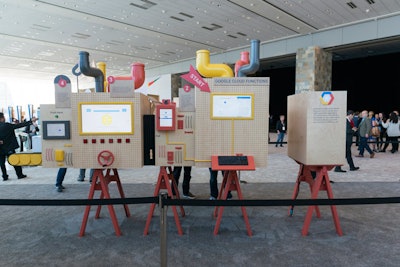
The exhibits were playful but still practical, and all designed in Google's brand voice.
Photo: David J Crewe
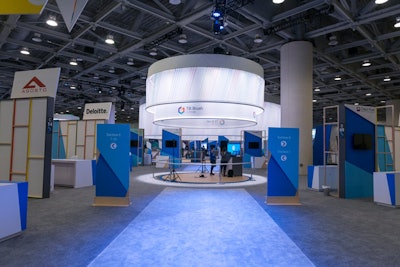
The partner pavilion had a more polished look that matched the keynote stage area.
Photo: David J Crewe
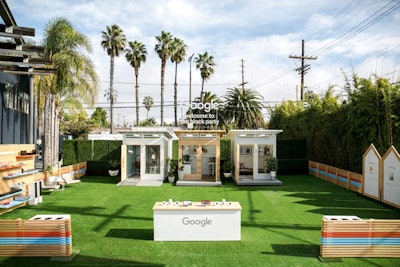
Google's first block party activation came to Abbot Kinney in Los Angeles from February 11 to 12.
Photo: Courtesy of Google

Inside the tent, Google set up a lounge for visitors.
Photo: Courtesy of Obscura Digital
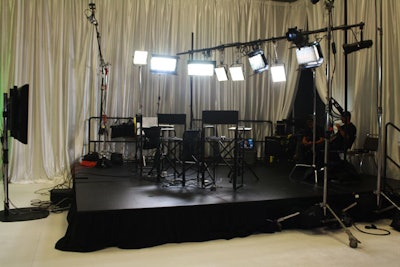
Fox News broadcast from an open studio in one corner of the room before, during, and after the debate.
Photo: BizBash
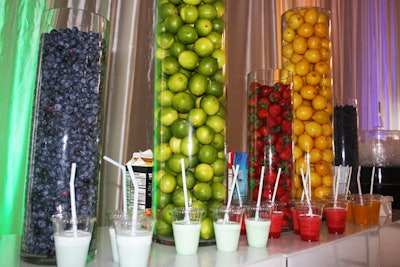
Decorative glass cylinders at the smoothie bar were filled with fruit that complemented the blue, green, red, and yellow accents in the room.
Photo: BizBash
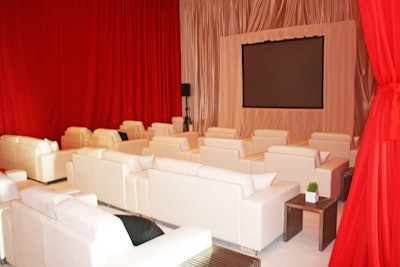
Journalists who did not have passes to be in the debate hall could watch the live stream in the YouTube Lounge, which was separated from the rest of the room by full-length red curtains and had four rows of white lounge furniture.
Photo: BizBash
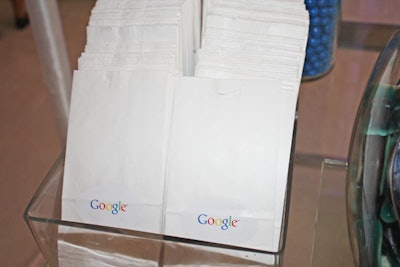
Google's name was visible throughout the room, even on paper bags at the self-serve candy station.
Photo: BizBash

Google commissioned custom pillows from a craftsperson on Etsy, each decorated with the symbol of a Google product, such as Gmail or the Chrome browser.
Photo: BizBash
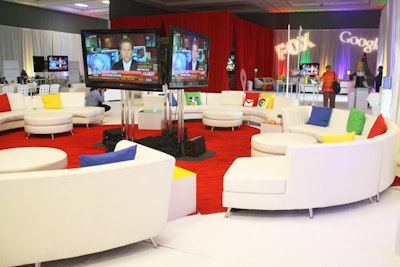
Organizers created distinct sitting areas in the 10,000-square-foot Google Media Filing Center and positioned 18 TVs around the room.
Photo: BizBash
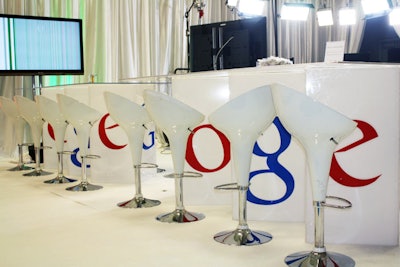
Tall cylindrical columns topped with glass created two bars with seating for 16 next to the Fox News stage.
Photo: BizBash
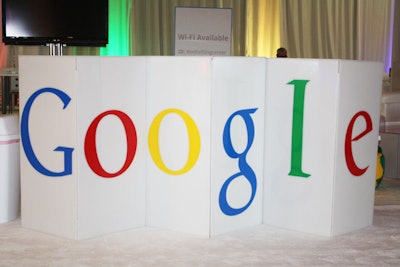
Just inside the entrance there were three four-foot-tall columns adorned with the Google name.
Photo: BizBash
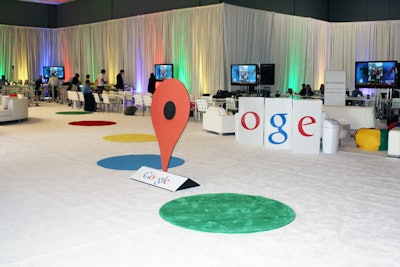
Colorful circles, each four feet in diameter, decorated the white carpet down the center of the room.
Photo: BizBash
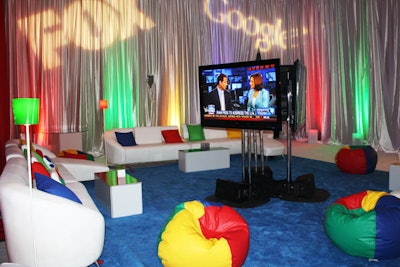
The Event Source created several groupings of white lounge furniture throughout the room. Each area included wide-screen TVs and colorful pillows, and some also had beanbag chairs.
Photo: BizBash
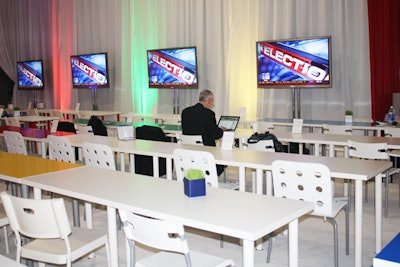
Organizers used tables and chairs from Ikea to create a work area in the back of the room with seating for 100.
Photo: BizBash
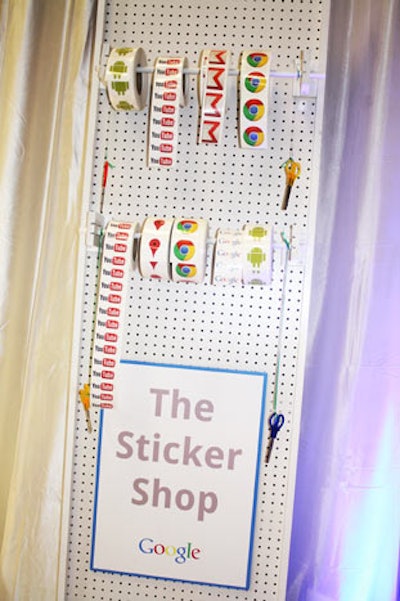
Just for fun, organizers invited journalists to help themselves to stickers of various Google product symbols.
Photo: BizBash
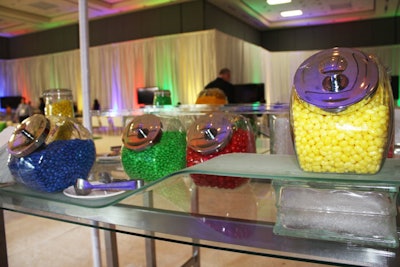
A self-serve candy bar offered sweets in the signature Google colors of blue, green, red, and yellow. Google also provided breakfast, lunch, and dinner from Centerplate.
Photo: BizBash
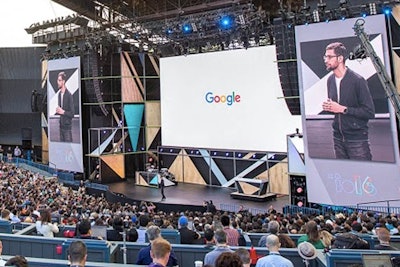
During the day, the amphitheater housed the keynote and other large presentations, and at night it was used for concerts.
Photo: Courtesy of Google
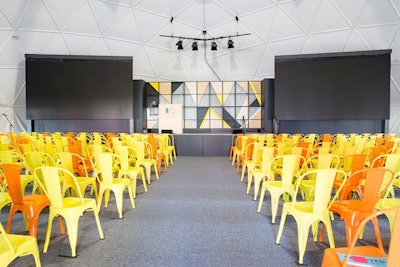
Breakout sessions took place in 10 fully enclosed stages around the event, with the smallest seating 100 people and the largest seating 1,200.
Photo: Courtesy of Google
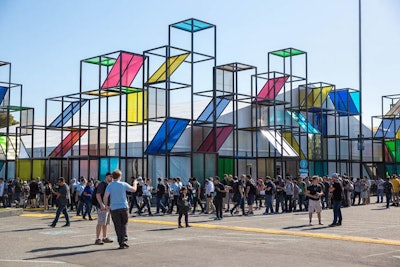
To create a fun, festival atmosphere at this year’s Google I/O, organizers used a variety of materials and colors to decorate the 10 tents that housed the breakout sessions.
Photo: Courtesy of Google
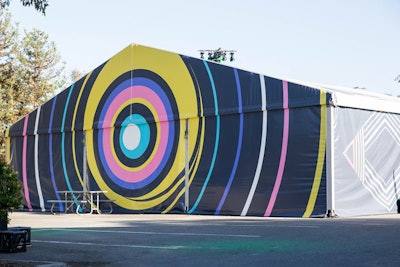
The art tent hosted technical sessions during the day, and at night it was used to demonstrate products such as Tilt Brush, Google’s 3-D virtual reality painting app.
Photo: Courtesy of Google
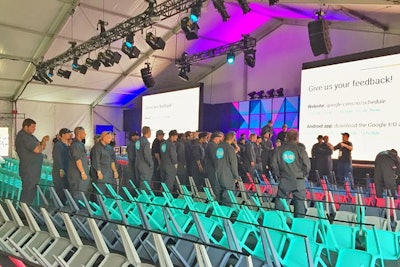
As soon as the educational sessions ended in late afternoon, the production crew arrived to transform the tents for nighttime social activities. Matuk said she outfitted them in painter’s overalls with the event logo on the back so they looked “like a pit crew coming in to change the space.”
Photo: Courtesy of Google
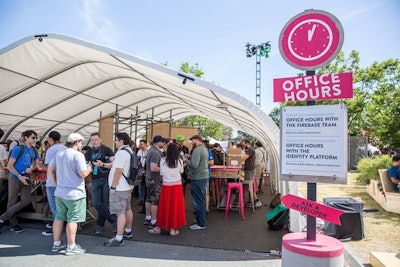
In the event's open-air tents, attendees could chat with Google engineers and test products.
Photo: Courtesy of Google
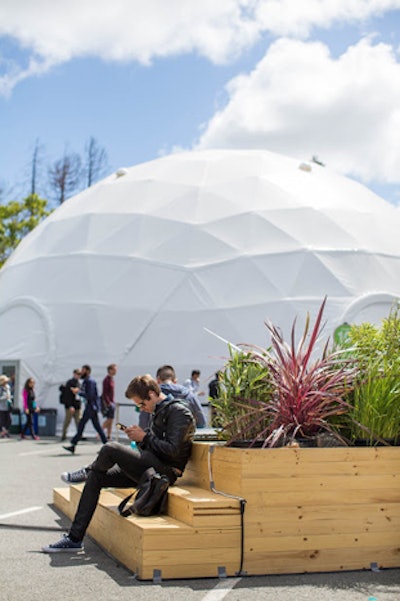
Matuk said she housed four of the breakout sessions in geodesic domes, "to add some visual interest to the landscape."
Photo: Courtesy of Google
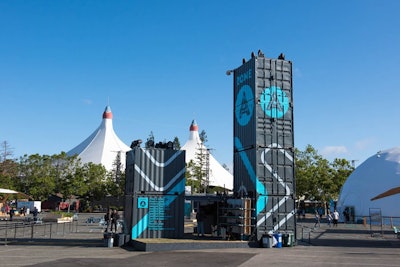
Organizers divided the grounds into four zones and stacked shipping containers to create towers to designate each area.
Photo: Courtesy of Google
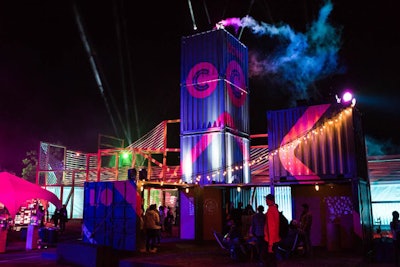
At night, colored smoke wafted from the four towers.
Photo: Courtesy of Google
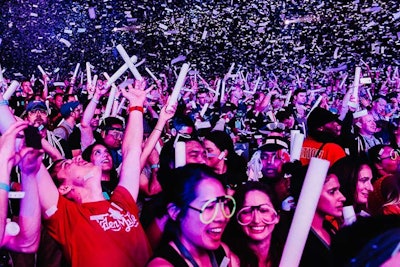
The first day of the conference ended with performances from Charli XCX and Kygo.
Photo: Courtesy of Google

A vintage Airstream trailer served as the first-aid facility for the event.
Photo: Courtesy of Google
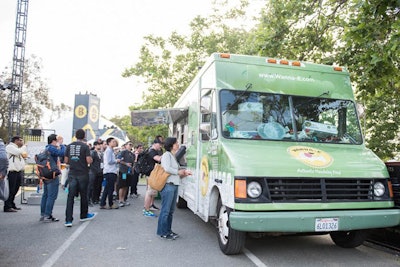
Meals were served by food trucks and from kitchens that organizers built on site.
Photo: Courtesy of Google

What organizers dubbed "art cars" were decorative elements during the day and at night became stages for musical performances.
Photo: Courtesy of Google
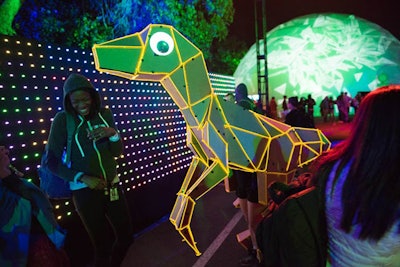
At night, performance artists, DJs, and colorful lighting added to the festival vibe.
Photo: Courtesy of Google
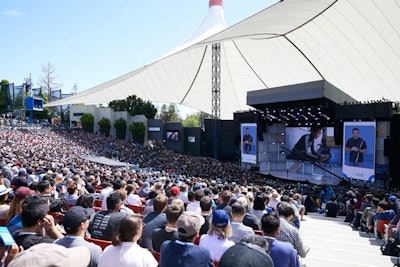
The 12th edition of Google I/O was held at the Shoreline Amphitheatre for the third consecutive year, drawing more than 9,000 attendees each day. Organizers expanded the event’s footprint this year, adding a ninth stage in a neighboring parking lot.
Photo: Courtesy of Google
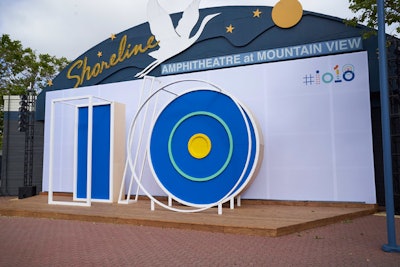
A three-dimensional version of the Google I/O logo offered a popular photo op area—and included the event's #IO18 hashtag.
Photo: Courtesy of Google
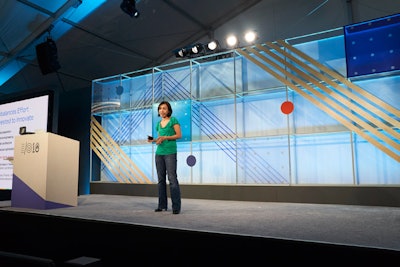
Stage backdrops complemented the year's logo design, with geometric, 3-D lines and circles. Google’s events and experiences team, as well as the developer marketing team, worked with Sparks on the event production.
Photo: Courtesy of Google
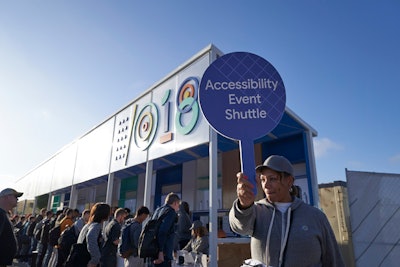
Organizers drew inspiration from wayfinding and line management tools at well-trafficked theme parks. “Wayfinding was the most obvious and apparent thing from the minute you walked on campus,” explained Google’s Amanda Matuk. “Everyone understood exactly where they were and where they were going at all points in time.”
Photo: Courtesy of Google

Colorful signage was displayed prominently throughout the campus. The conference continued last year’s method of a neighborhood-like design, with a single Main Street connecting all areas of the massive event.
Photo: Courtesy of Google
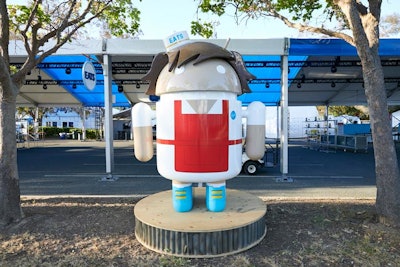
Larger-than-life versions of Bugdroid, the Android mascot, marked certain areas of the event—such as the food pavilion—and also provided fun photos ops.
Photo: Courtesy of Google
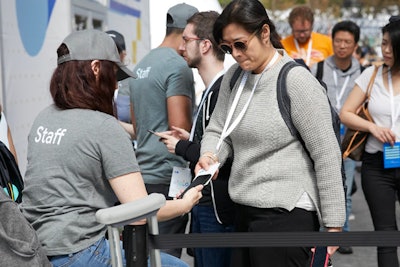
New this year was an increase in information-sharing: Attendees could scan their badges at any session to receive more details on the topic.
Photo: Courtesy of Google
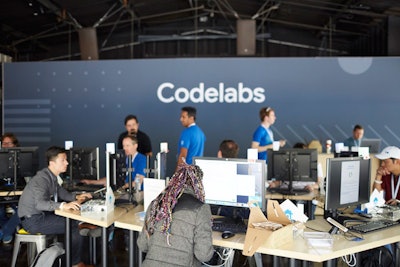
The on-site Codelabs allowed attendees to get hands-on coding experience at kiosks. The event also included Sandboxes, which were dedicated spaces to learn about and test Google’s latest products and platforms.
Photo: Courtesy of Google
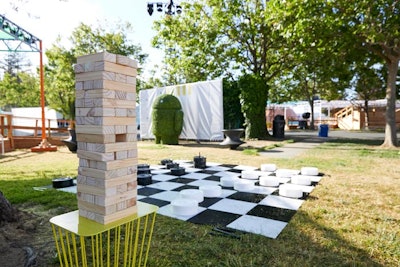
As in previous years, the conference incorporated music-festival-inspired elements, such as oversize Jenga and Checkers games.
Photo: Courtesy of Google
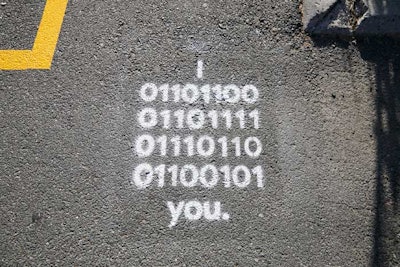
Tongue-in-cheek signage on the ground added a fun touch for the crowd of developers, including one that spelled out “I love you” in binary code.
Photo: Courtesy of Google
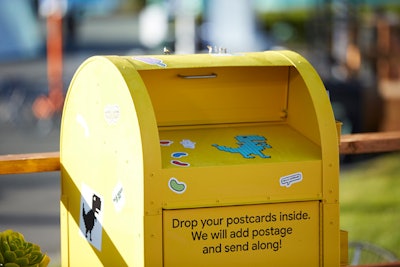
As in years past, organizers provided postcards and invited attendees to write a note to a colleague, friend, or family member and drop it into one of the mailboxes located around the event. The goal was to add an analog touch to a tech-heavy environment.
Photo: Courtesy of Google
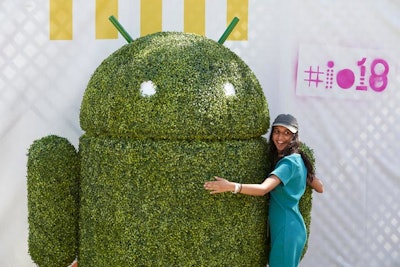
Another Budgroid photo op area featured a version made from greenery.
Photo: Courtesy of Google
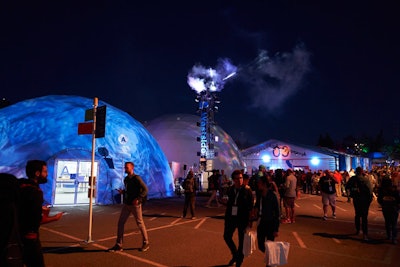
Large tents that held sessions during the day were illuminated for the nighttime events, which included an arcade, musical entertainment, magic shows, and more.
Photo: Courtesy of Google
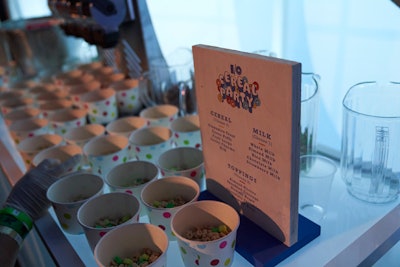
One evening event featured a cereal station as an out-of-the-box dessert.
Photo: Courtesy of Google
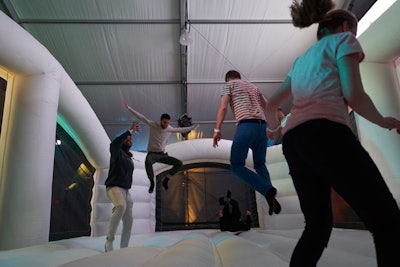
Attendees could also unwind after hours in a moon bounce.
Photo: Courtesy of Google
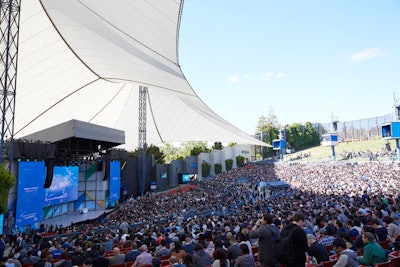
The amphitheater housed the keynotes and large breakout sessions. The rest of the conference took place in structures set up in the venue's parking lot.
Photo: Courtesy of Google
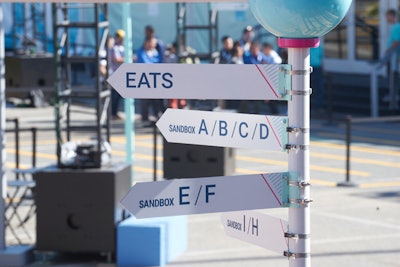
Based on feedback from the 2016 event, organizers added more wayfinding tools, such as signposts and maps.
Photo: Courtesy of Google
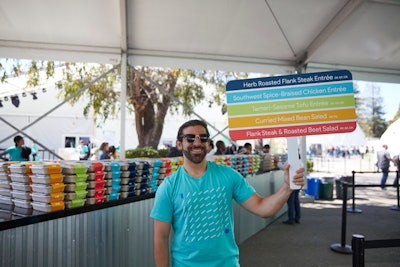
To improve the flow of attendees through the food area, staff held color-coded menu signs that corresponded to the colors on the packaged food. Matuk said the system worked well and allowed 7,200 people to be fed in 45 minutes.
Photo: Courtesy of Google
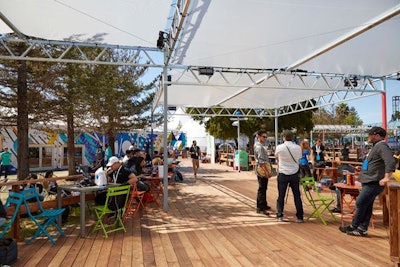
After dealing with extreme heat in 2016, this year organizers created 30,000 square feet of shaded areas outside the session structures.
Photo: Courtesy of Google
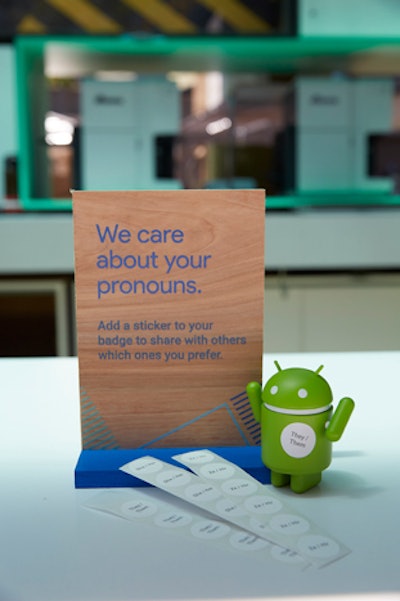
To foster inclusivity, Google invited attendees to add stickers to their badges to indicate which pronouns they prefer to describe themselves.
Photo: Courtesy of Google
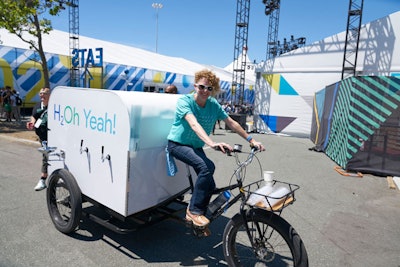
Six cyclists pulled mobile water-filling stations around the event, targeting areas where attendees gathered.
Photo: Courtesy of Google
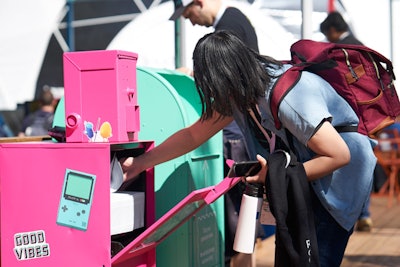
Organizers provided pre-stamped postcards and invited attendees to write a note to a colleague, friend, or family member and drop it into one of the mailboxes located around the event. Matuk said the purpose was to create a “nice human, analog moment in a digital, tech-forward environment.”
Photo: Courtesy of Google
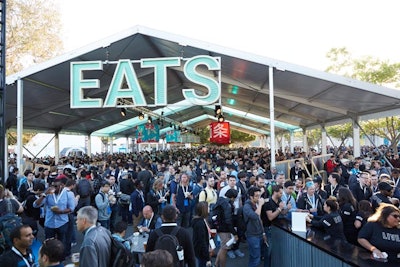
This year organizers created the “Eats Market,” a large pavilion where they served lunch each day. Matuk said this worked much better than their system in 2016 when they had 15 food stations spread through the event.
Photo: Courtesy of Google
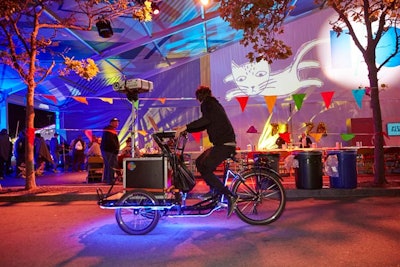
The large tents that housed sessions during the day became canvases for pop-up artwork during the opening night Block Party. Cyclists with projectors mounted on their bikes would stop to show a scene or short film on the side of the tent.
Photo: Courtesy of Google
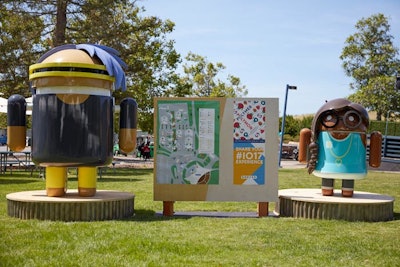
Organizers prominently displayed large "you are here"-style maps throughout the venue. The back of each map was a community billboard where they posted updates about sessions and after-hours events.
Photo: Courtesy of Google
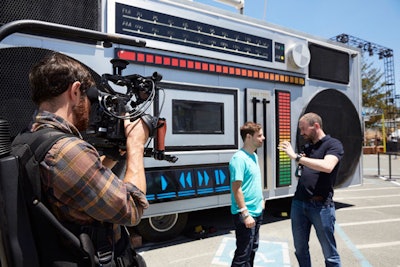
Four “live guides” traveled around the event with a camera person to provide content for the online audience. The majority of the content was pre-selected by Google, but some was based on questions and requests submitted via social channels.
Photo: Courtesy of Google
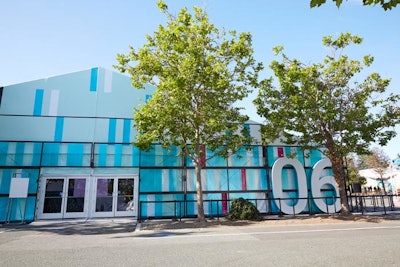
The colorful tents from 2016 returned, but this year organizers numbered them to aid with wayfinding.
Photo: Courtesy of Google
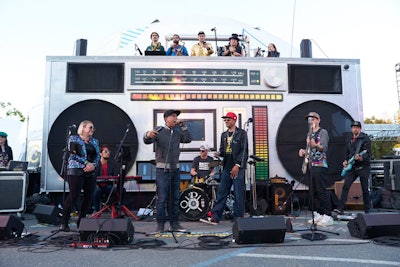
A massive boombox served as the backdrop for a hip-hop band and DJ at the Block Party on the first night of the conference. The event included additional entertainment, an arcade, a virtual-reality movie experience, food, and more.
Photo: Courtesy of Google
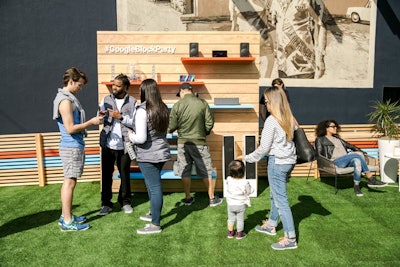
A sound wall played music and featured the event's hashtag. Product specialists were on site to answer consumer questions.
Photo: Courtesy of Google
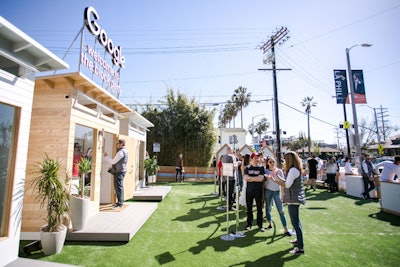
Three tiny homes served as the focal point of the activation, with signage welcoming people to the event.
Photo: Courtesy of Google
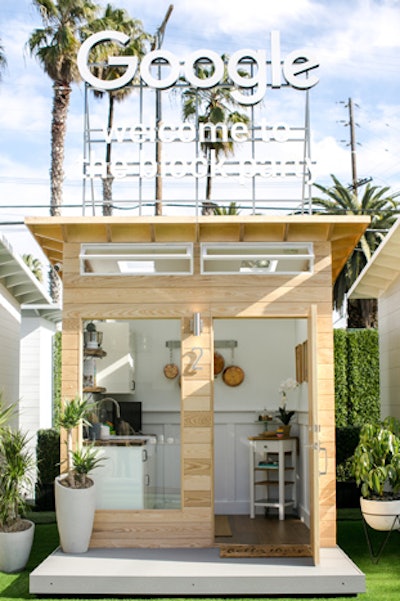
The tiny home inspired by MyCupcakeAddiction was designed as a kitchen.
Photo: Courtesy of Google
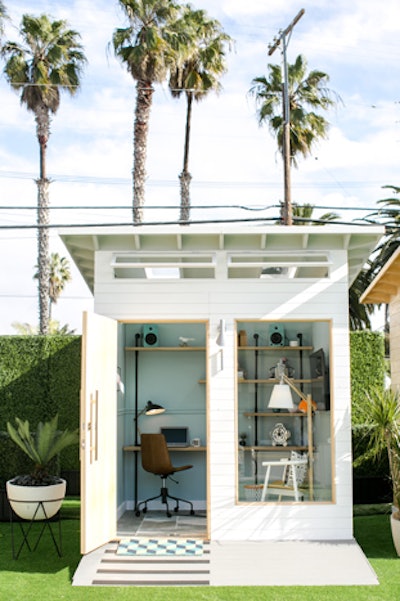
The home for Wong Fu Productions was designed to resemble a home office.
Photo: Courtesy of Google
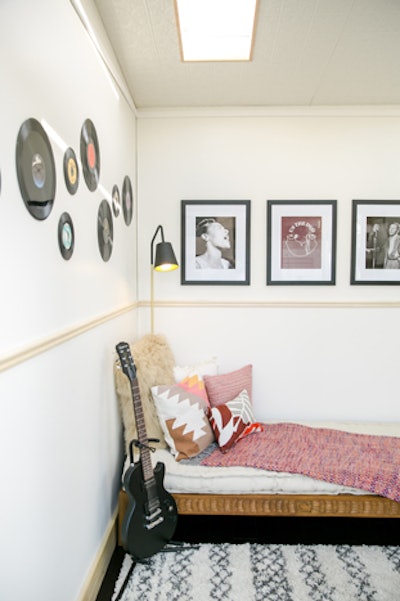
Inside the home inspired by Us the Duo, decor included records, a guitar, and portraits of musicians.
Photo: Courtesy of Google
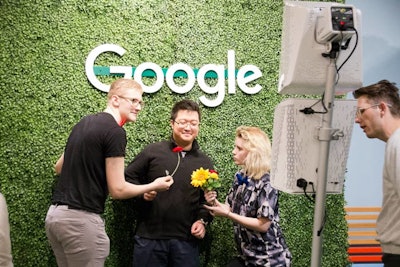
The New York block party took place February 24 to 26 at Chelsea Market. The event featured a GIF photo booth with props and a branded greenery backdrop.
Photo: Taylor McIntyre/BizBash
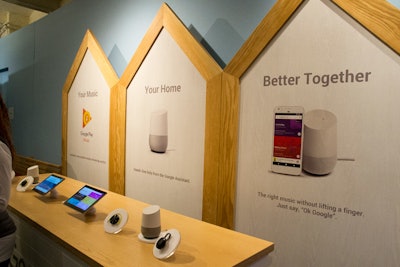
The activation included a station with product demos and images that highlighted the purpose of the block party.
Photo: Taylor McIntyre/BizBash
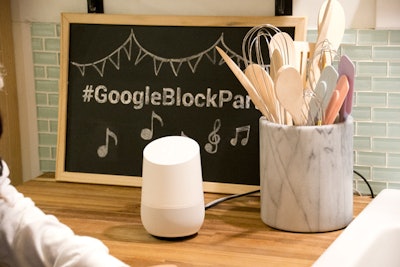
Each tiny home incorporated the event hashtag, including on a mini chalkboard.
Photo: Taylor McIntyre/BizBash
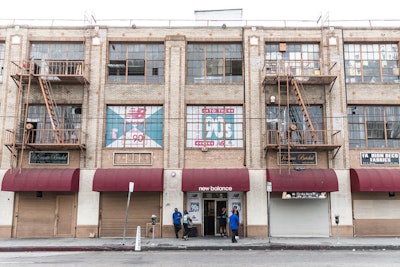
The pop-up took over 939 Studio, a raw event space in downtown Los Angeles. Subtle signage was visible from the street.
Photo: E. Geno Frazier/Langley Avenue

The space was designed to promote New Balance’s new X-90 Knit—a sneaker that combines “the best of the ‘90s with 2018 street style,” according to the brand. A series of rooms had a variety of decade-appropriate designs, including one using pink and teal that matched the shoe design.
Photo: E. Geno Frazier/Langley Avenue
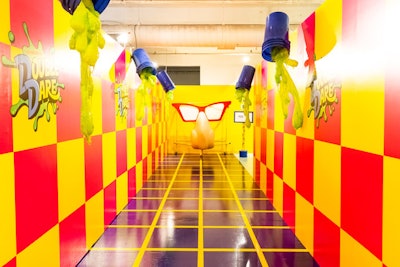
A colorful hallway was inspired by Nickelodeon’s Double Dare—complete with green slime and a giant nose that proved a popular spot for photo ops.
Photo: E. Geno Frazier/Langley Avenue

A bedroom set had posters for Dr. Dre, Beastie Boys, and others 1990s favorites on the walls. Products from the new shoe line were displayed on the bed.
Photo: E. Geno Frazier/Langley Avenue

Another area of the room had posters for Pulp Fiction and other era-appropriate pop culture, plus a lava lamp and an old-school TV set.
Photo: E. Geno Frazier/Langley Avenue
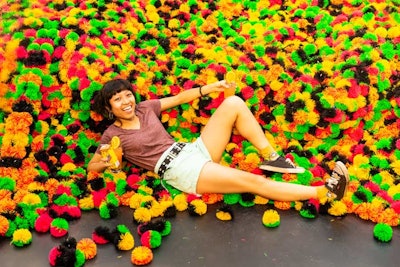
In a twist on the ball pit photo op, guests could lay in a pool of colorful Koosh balls, a popular ‘90s toy.
Photo: E. Geno Frazier/Langley Avenue
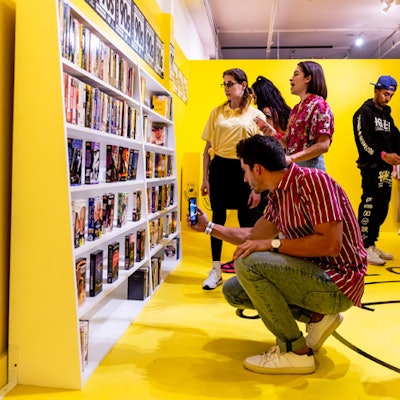
What’s the 1990s without a trip to Blockbuster? One area of the space had a wall of old VHS tapes.
Photo: E. Geno Frazier/Langley Avenue
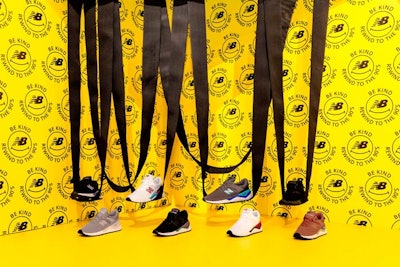
The New Balance shoe line was displayed throughout, including in the video store area—the black tape from an oversize VHS tape was used to hold the product. Signage played off the old "Be Kind, Rewind" slogan, instead saying "Be Kind, Rewind to the '90s"—the name of the pop-up.
Photo: E. Geno Frazier/Langley Avenue
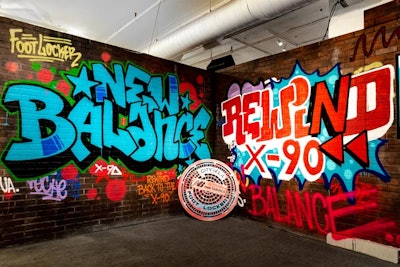
Graffiti on the walls promoted the New Balance and Foot Locker brands.
Photo: E. Geno Frazier/Langley Avenue
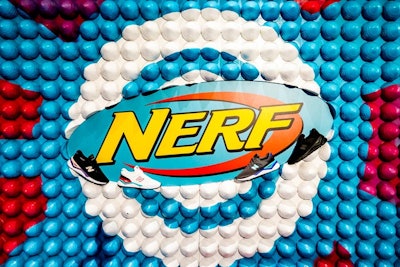
A wall made from Nerf toys offered a fun photo op.
Photo: E. Geno Frazier/Langley Avenue
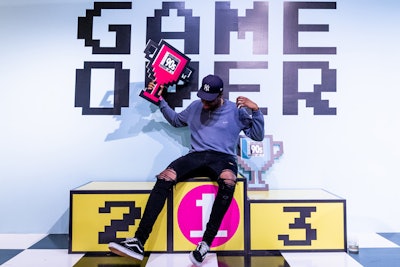
Another photo op resembled the end of an old-school video game.
Photo: E. Geno Frazier/Langley Avenue
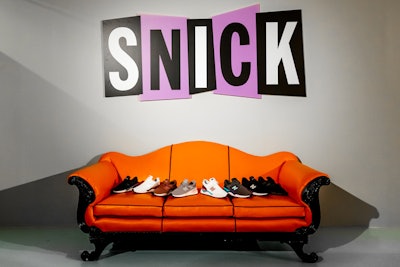
Shoes were also displayed on a couch that threw back to ‘90s TV show SNICK.
Photo: E. Geno Frazier/Langley Avenue
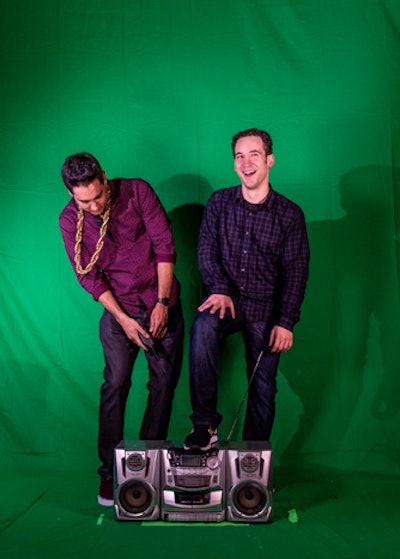
Boy Meets World star Ben Savage attended the opening-night party, where guests could pose in front of a green screen and later see the images displayed on old televisions.
Photo: E. Geno Frazier/Langley Avenue
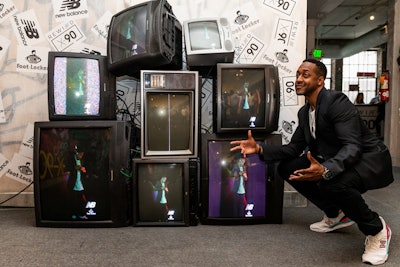
Family Matters star Jaleel White also took advantage of the photo op.
Photo: E. Geno Frazier/Langley Avenue



















